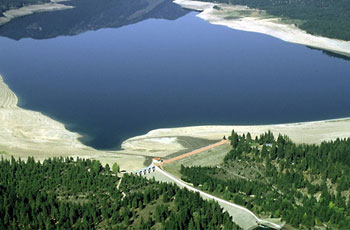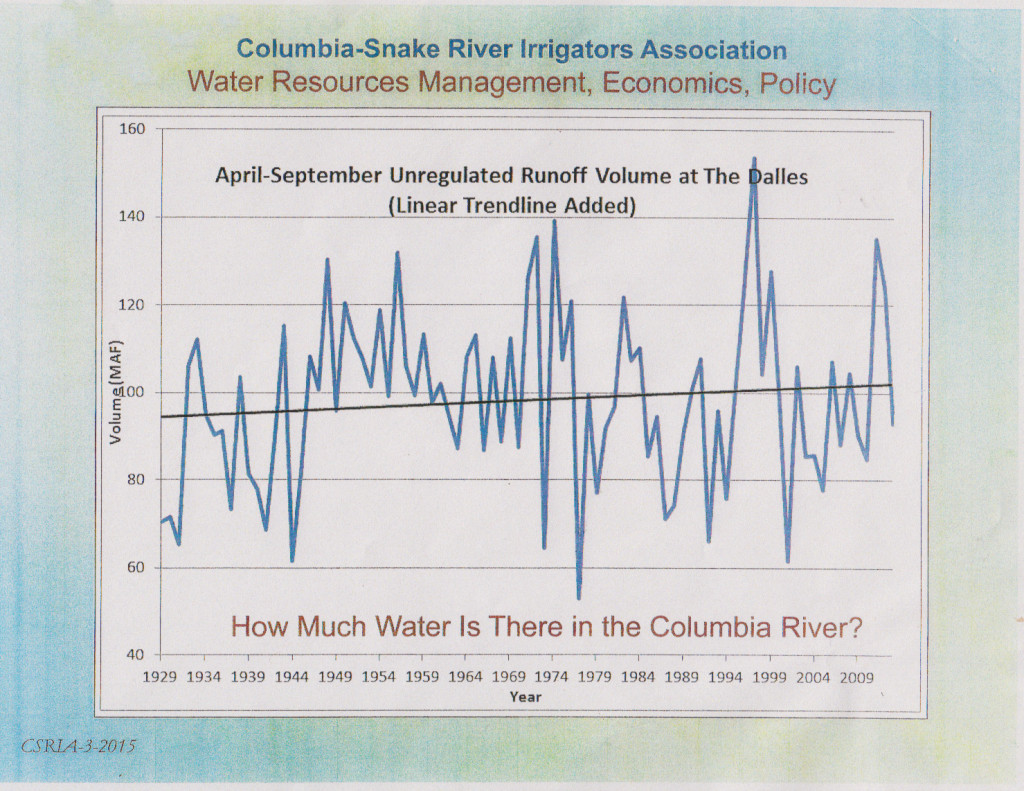YBSA Monthly Report July, 2015
YBSA Monthly Report
July, 2015
Water Storage in the Yakima Basin: The graph prepared by the Bureau of Reclamation shows the 5 reservoirs in the storage system (in acre-feet), as of July 30th, the stored water level is just below 600,000. Average storage for this time of year is just below 800,000 acre-feet. As of July 30th the present capacity in all the reservoirs is 53%. Lake Cle Elum, the largest of all the reservoirs, has 35% of the water left in the lake.
Lake Cle Elum
High Temperatures in Rivers: Sockeye Salmon are dying in parts of the Columbia River due to water volume and high temperatures. Temperature of the lower Yakima River is exceeding 70°. The fish returning to the river to head upstream may get stranded or could be harmed by shallow, warmer stream temperatures.
Upcoming Temperatures: The Weather Channel is predicting that temperatures in the lower Yakima Basin will fluctuate from the mid 80° to 100° through the month of August with 80° continuing through the month of September.
Go to www.ybsa.org for additional information.
YBSA Monthly Report June, 2015
YBSA Monthly Report
June, 2015
Reservoirs and Available Water: As of June 29th the percentage of total capacity of the five reservoirs is 76%. With the snowpack at 0% the inflow into the five reservoirs is 25% and the releases from all five are 95%. Unregulated flow in the Yakima River near Parker is 13% and observed flow is 37% of average. Roza Irrigation District is adding 90 cublic feet per second (cfs) and Sunnyside Irrigation District is adding 40 cfs to their delivery systems.
Drought Impact on Agriculture for Junior Water Users: The Department of Agriculture report on May 11th of their assessment of the 2015 Drought Agricultural Economic Impact provides the following information pertaining to the Yakima Valley. The first water uses curtailed during a drought are those held by junior water users. For this analysis, the U.S. Department of Agriculture’s Natural Resources Assessment Section (NRAS) assumed a 50% crop loss in two major junior water right irrigation districts, Roza Irrigation District (Roza) and Kittitas Reclamation District (KRD). Both districts were contacted and provided crop acreage information to assist the analysis. The total crop loss value estimated in these two districts (based on top three crops in KRD and top eight crops in Roza) is $243 million.
This is a conservative estimate, and in no way reflects secondary economic impacts potentially caused by this drought including less need for labor, shorter packing seasons, lower crops or the impact of low soil moisture on crops normally planted in the fall. Those costs will not be fully realized until 2016 at the earliest.
Time to Revive the Black Rock Reservoir Plan by Don C. Brunell: Yakima Valley farmers have the same problem as their California counterparts: there just isn’t enough water for crops, migrating fish and people.
With snowpack in the Cascades at a dismal 10 percent of normal, Yakima farmers are struggling to stretch available water supplies during the upcoming summer months when irrigation water is most needed. The situation has once again prompted state and federal officials to consider adding water storage capacity.
Considering that, it is time to dust off the Black Rock project, which, as originally conceived, would transfer spring runoff water from the Columbia River in central Washington uphill to a new reservoir east of Yakima.
In 2008, the U.S. Bureau of Reclamation determined that the Black Rock Reservoir would be too costly. The estimated cost then was about $5.69 billion, but it could potentially climb to as high as $7.7 billion. At the time, the Bureau reported that Black Rock would return 13 cents for every dollar spent to build and operate. (the Integrated Plan, if completely implemented, would cost in excess of $5 billion.)
Over the last eight years, massive amounts of wind generation have come on line, which means, in addition to an irrigation lake, Black Rock could become a pumped storage facility generating hydropower from wind power.
A pumped storage project using wind-generated electricity would provide a storage battery for energy and would benefit fish, agriculture, municipal needs and economic stability while leaving a reliable water supply in the Yakima River.
Black Rock could become more than just an irrigation reservoir; it would ease the demand to divert water from the Yakima River for irrigation, leaving more water in the river, which would raise stream flows, which in turn would improve salmon and steelhead habitat.
See the full article by Dan Brunell on www.ybsa.org.
How much water is there in the Columbia River?: The following graph (below) presented by the Columbia-Snake River Irrigators Association shows the April-September unregulated runoff at the Dalles (linear Treadline Added). The volume of water in the Columbia has increased and the volume now is more than 100 million acre/feet annually.
Work Group Now Including Possible Transfer of Columbia River Water: At the June 3rd, 2015 Yakima River Basin Water Enhancement Project Work Group (IP) meeting a list of surface water storage activities was provided. For the first time a report included; begin appraisal of potential projects to transfer water from the Columbia River to the Yakima Basin. For a complete report on the Yakima River Basin Water Storage Feasibility Study (Storage Study) go to www.ybsa.org and in the archives read “The Black Rock Project” and the “Columbia River Pumped Storage Reservoir Reports”.
Go to www.ybsa.org for additional information.

